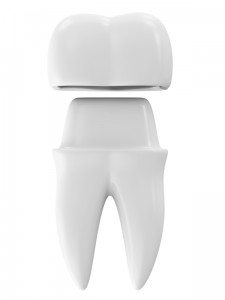 In 1903, Charles Land, the grandfather of aviator Charles Lindberg, made a dental cap out of porcelain.
In 1903, Charles Land, the grandfather of aviator Charles Lindberg, made a dental cap out of porcelain.
For hundreds of years, before the “porcelain jacket crown” was invented by Land, dentists tried using materials like ivory, gold and human bone in patients’ jaws to replace missing teeth. Even human teeth and various metals were tried, but the body rejected these materials.
The idea of saving the tooth and placing a dental cap, or crown, on the tooth, was part of the evolution of cosmetic dentistry.
A problem with Charles Land’s porcelain crowns was their tendency to crack. In the late 1950s, Abraham Weinstein patented porcelain-fused-to-metal caps, which proved to be stronger than porcelain only.
 The 1950s was a time when new plastics and acrylic compounds were being made. Even researchers at the Corning Glass Works, in Corning, New York, were working on glass compounds that could be used to make strong teeth caps. All this, and continued research, has led to materials that are used for the esthetically pleasing and strong caps that are used today.
The 1950s was a time when new plastics and acrylic compounds were being made. Even researchers at the Corning Glass Works, in Corning, New York, were working on glass compounds that could be used to make strong teeth caps. All this, and continued research, has led to materials that are used for the esthetically pleasing and strong caps that are used today.
The Advantage of Dental Caps
The hope we all have, is that all of our teeth will serve us well during the course of our lives. That is the ideal. But with a lifetime of use, our teeth get worn down with daily use and can also deteriorate because of diet, genetics and poor oral hygiene.
If a tooth is broken or discolored, and can be saved instead of pulled out, a dental cap may be a good solution.
- Cover discolored or broken teeth
- Cover a dental implant
- Protect a tooth from decaying
- Hold a dental bridge in place
When and Why Get Dental Caps
After an assessment to evaluate the health of the tooth, Dr. Stone may recommend placing a Dental Cap on the tooth. The advantage of doing this, is that the tooth will be saved and, since the tooth remains in the jaw, bone will not be lost.
Contact our office for an assessment or if you have any questions about Dental Caps.
Call Us: 954-568-9100
Contact us if you have a question or to
schedule your complimentary consultation!

